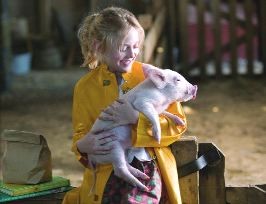Animal friends

Devotees of children’s literature have received an unexpected lift from the nearly simultaneous release of the new film of Charlotte’s Web, based on the story by E. B. White, and Miss Potter, a biography of Peter Rabbit’s creator, Beatrix Potter. Each in its way is a charmer.
Gary Winick (whose last picture, 13 Going on 30, was built around Jennifer Garner’s remarkably intuitive performance as a teenager who wakes up one morning to find she’s suddenly become an adult) has just the right touch for Charlotte’s Web, which he’s made as a combination of live action and computer animation, like Babe. (A straight cartoon version of Charlotte’s Web came out in 1973.)
Chris Noonan, Babe’s talented director, is responsible for Miss Potter, in which the title character (played by Renée Zellweger) communes with the animal characters in her illustrations. The sly, almost offhand animation recalls pioneering Disney shorts like Steamboat Willie and the Silly Symphonies, as well as the no-big-deal cartoon inserts in experimental early sound pictures.
In the midst of a rich Christmas movie season, Charlotte’s Web didn’t receive much notice, but it’s marvelous—everything a lover of White’s novel might want from a film adaptation. Winick and screenwriter Susannah Grant retain White’s distinctive style (elegant simplicity) and tone (plain-spoken, rich in feeling yet unsentimental), while Seamus McGarvey’s lovely pastoral cinematography picks up White’s theme: the miraculousness of everyday existence.
For ebullient Wilbur (voiced by Dominic Scott Kay), the runt of the pig litter, rescued from death by a humane, insistent little girl named Fern (Dakota Fanning), life is a cornucopia of gift: sunshine, shelter, slops. The greatest gift is friendship. In Fern’s uncle’s barn, Wilbur, blissfully free of social prejudices, enthusiastically accepts the friendly overtures of a spider named Charlotte (Julia Roberts, whose line readings are a model of emotional tact).
It becomes Charlotte’s mission to find a way to underscore Wilbur’s special qualities so that Fern’s uncle (Gary Basaraba) and aunt (Siobhan Fallon Hogan) view him as indispensable and not as food for the holiday table. Her solution is to weave messages like “Some pig” into her web. In the magical sequence where she spins her first words, Winick brings us right into the depths of her gossamer realm.
Charlotte’s Web has a prize cast of voice actors: John Cleese as the sheep, Oprah Winfrey and Cedric the Entertainer as the geese, Kathy Bates and Reba McEntire as the cows, Robert Redford as the horse, Thomas Haden Church and André Benjamin as the crows, Abraham Benrubi (of TV’s ER) as the empty-headed pig who towers over Wilbur and is his competition for the blue ribbon at the county fair. Best of all, Steve Buscemi lends his scruffy, low-down wit and his tone of misanthropic bemusement to the crucial role of Templeton, the solipsistic barn rat whose aid Charlotte secures in a series of ingenious, pragmatic negotiations.
Designed and shot with a palette that evokes the muted confectionery look of the author’s celebrated drawings, Miss Potter shares some of the becoming modesty of Charlotte’s Web. It’s a slight film; not much happens in it. Beatrix, a turn-of-the-century spinster who struggles against the continuous disapproval of a conventional mother (Barbara Flynn), surprises everyone—except her adoring father (Bill Paterson)—by landing a publisher for her first children’s book, The Tales of Peter Rabbit. Her editor, Norman Warne (Ewan McGregor), falls in love with her; his sister, Millie (Emily Watson), becomes her dearest friend. Richard Maltby Jr.’s script reserves the only tragedy in the story for the last third. The picture rings in at a mere—but very pleasurable—92 minutes. It’s literate, with a knobby, fond sort of humor, and its forthright, independent-minded women (including Norman’s affectionate mother, played by Phyllida Law) are inspiriting.
Zellweger takes some getting used to as Beatrix; her hold on the character’s eccentricity is perhaps too tenacious. But the combination of Watson and McGregor, the most effortlessly affable brother-and-sister act in recent movies, warms her up. She’s at her best when fate pulls the rug out from under her. So is Noonan’s direction. As he and Maltby conceive this scene, Beatrix suddenly loses control of the fictitious animal figures she’s thought of as her friends and that the movie sees as her alter egos: they run amok, elude her, vanish from the drawing board. Their rebellion isn’t mischievous but panicked, and it symbolizes the chaos into which her grief sends her imaginative life. In this scene, as in much of Babe, Noonan is a manufacturer of nostalgic treasures who knows how to sound their secret depths.





